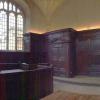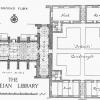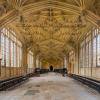Convocation House (1634-7) and university governance
External links
Commentary
The manner in which the ‘universitas’ was defined varied from one institution to another. In some of the oldest Italian universities, the ‘universitas’ was the whole company of students, who took the initiative in organising the provision of teaching on their own behalf. Later, many universities defined the university as the universitas magistrorum et scholarium, that is, the whole company of teachers and students.
In Oxford, the university has been defined in several different ways, which have competed with one another for authority for hundreds of years. (1) One definition is that contained in the legal name mentioned previously: ‘The Chancellor, Masters, and Scholars of the University of Oxford’. This definition includes the students as well as the teachers and senior University officers within the University. (2) Today, the University of Oxford is governed by ‘Congregation’. Congregation originally comprised all the ‘regent masters’, that is to say, all the MAs actually teaching within the University (who were described as ‘regent’ because they governed the institution). (3) The third term, ‘Convocation’, is the name given to 'the great Congregation' including both regent and non-regent masters of the University, that is to way, all holders of masters degrees recognized by the colleges of Oxford, irrespective of whether they are currently teaching in the University.*
Prior to the late 13th century and again between 1508 and 1636, the University was governed by Congregation, which met in Congregation House, which was built c. 1320 as an annexe to the University Church. In 1636, Title X of the Laudian Statutes reinstated Convocation as the supreme legislative authority of the University. In order to house it, Convocation House was built between 1634 and 1637, accessible through a doorway at the western end of the Divinity School. The Chancellor presided from a throne located at the southern end of the room, while the regent and non-regent masters sat in long benches against the walls in the manner reminiscent of a monastic chapter house or cathedral choir. A doorway at the north end of the room leads to the Chancellor's Court. The woodwork - including the panelling, stalls, and throne - is all from the seventeenth century, but the fan vault was added in 1758-9. Shortly after it opened, the House of Commons met in this chamber, returning again during periods of plague in London in the 1660s and 1680s.
* The Victoria County History summarizes the resulting status of Convocation as follows: ‘Convocation was to consist of the Chancellor or Vice-Chancellor, the proctors, and regent and non-regent doctors and masters. Its functions were to accept or reject any motion respecting statutes, &c., of the Hebdomadal Board after it had been submitted to Congregation; to elect officers, professors, and public lecturers; to nominate delegates; to grant dispensations; to present to benefices; to examine accounts; to control the letting of lands; to dispatch letters to royalty, &c.; to grant honorary degrees and to deprive offenders of degrees.’ As for Congregation, after 1636 ‘Its functions were to deliberate on the resolutions of the Hebdomadal Board; to grant graces, and, in certain cases, dispensations; to admit to degrees; to grant incorporations; and to give letters testimonial.’ H E Salter and Mary D Lobel, eds., An Account of the University of Oxford: Its History, Buildings, Colleges and Halls [= Victoria County History: Oxfordshire, vol. 3] (London, 1954), ch. 1.
Further resources. A 3D panorama of the Chancellor's Court can be accessed here (via the Divinity School).
Credits: Howard Hotson (September 2016 / December 2018).



